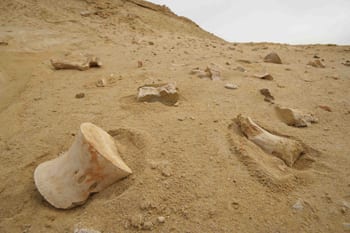 The research of an international paleontological team working in Angola and co-led by SMU paleontologist Louis L. Jacobs has been covered by Bloomberg news service.
The research of an international paleontological team working in Angola and co-led by SMU paleontologist Louis L. Jacobs has been covered by Bloomberg news service.
Fossils in the rock outcrops of the coast of Angola in Africa are a “museum in the ground,” says SMU vertebrate paleontologist Jacobs. Reporters Colin McClelland and Manuel Soque with Bloomberg interviewed Jacobs for Ancient Angola Crocodile Ate Fish as Oil Fields Formed. Business Week also published the story “Ancient Angola Crocodile Feasted on Fish as Oil Fields Formed.”
“Angola is the final frontier for palaeontology,” Jacobs has told reporters about the PaleoAngola project. “Due to the war, there has been little research carried out… but now we are getting in finally and there is so much to find. In some areas there are literally fossils sticking out of the rocks, it is like a museum in the ground.”
SMU paleontologist Michael J. Polcyn is also a member of the Projecto PaleoAngola team.
EXCERPT:
By Colin McClelland
and Manuel Soque
Bloomberg
Scientists have found a new type of crocodile that trundled across Angola millions of years ago while the crude oil that it now pumps as Africa’s second-largest producer was forming.PaleoAngola, a team of fossil-hunters from the U.S., Portugal, Angola and the Netherlands, found the reptile’s 30 million-year-old remains this year on a beach within sight of oil rigs drilling into the same rocks offshore Cabinda province north of the Congo River.
“The croc is certainly new to the age in which it was found,” Louis Jacobs, geology and paleontology professor at Southern Methodist University in Dallas, said in an e-mailed response to queries yesterday. “It would have been the size of a large modern croc, but two-thirds of the head would have been a narrow snout adapted for fish eating.”
Some of the 1.78 million barrels-a-day Angola pumped in July was formed around the same time as the crocodile fossil, after Africa and South America broke apart through plate tectonics. Oil explorers such as ConocoPhillips (COP) and BP Plc (BP/) are betting on the industry’s Atlantic mirror theory which says there may be huge deposits of oil deep beneath the sea off West Africa, similar to those across the ocean in Brazil.
Resembles Gharial
The crocodile, which is yet to be named, may be related to a fossil found in the province almost 100 years ago and a more recent find in Kenya, Jacobs said. The beast was probably coastal and isn’t directly related to modern African crocodiles, he said. It resembled a gharial, but wasn’t one, he said. Gharials are a type of crocodile found in Asia.The team also found a well-preserved skull of a 70 million-year-old mosasaur, sometimes called a marine monster, north of Luanda, the capital, and another in southern Namibe province with three smaller ones in its stomach.
“Quite a last meal,” Jacobs said.Other finds this year include a tooth from an arsinoitherium, a rhino-like animal with two large horns forming a V off its nose that is known from digs in Egypt, and skulls of 18 million-year-old relatives of the pygmy right whale, which swims off Angola’s southern coast today, Jacobs said. They’re the continent’s only fossils of the oldest filter-feeding whales known from Africa, he said. One skull has two fish fossils in its blow hole.
Follow SMUResearch.com on Twitter.
For more information, www.smuresearch.com.
SMU is a nationally ranked private university in Dallas founded 100 years ago. Today, SMU enrolls nearly 11,000 students who benefit from the academic opportunities and international reach of seven degree-granting schools. For more information see www.smu.edu.
SMU has an uplink facility located on campus for live TV, radio, or online interviews. To speak with an SMU expert or book an SMU guest in the studio, call SMU News & Communications at 214-768-7650.
 The research of an international paleontological team working in Angola and co-led by SMU paleontologist
The research of an international paleontological team working in Angola and co-led by SMU paleontologist 
 The Undying Radio: Familiarity breeds content when it comes to listeners and music
The Undying Radio: Familiarity breeds content when it comes to listeners and music Mosquito indexing system identifies best time to act against potential West Nile Virus outbreaks
Mosquito indexing system identifies best time to act against potential West Nile Virus outbreaks Sweden, SMU psychologists partner to launch parenting program that reduces child abuse
Sweden, SMU psychologists partner to launch parenting program that reduces child abuse Chemical probe confirms that body makes its own rotten egg gas, H2S, to benefit health
Chemical probe confirms that body makes its own rotten egg gas, H2S, to benefit health Study: High-volume Bitcoin exchanges less likely to fail, but more likely to suffer breach
Study: High-volume Bitcoin exchanges less likely to fail, but more likely to suffer breach Musicians who learn a new melody demonstrate enhanced skill after a night’s sleep
Musicians who learn a new melody demonstrate enhanced skill after a night’s sleep